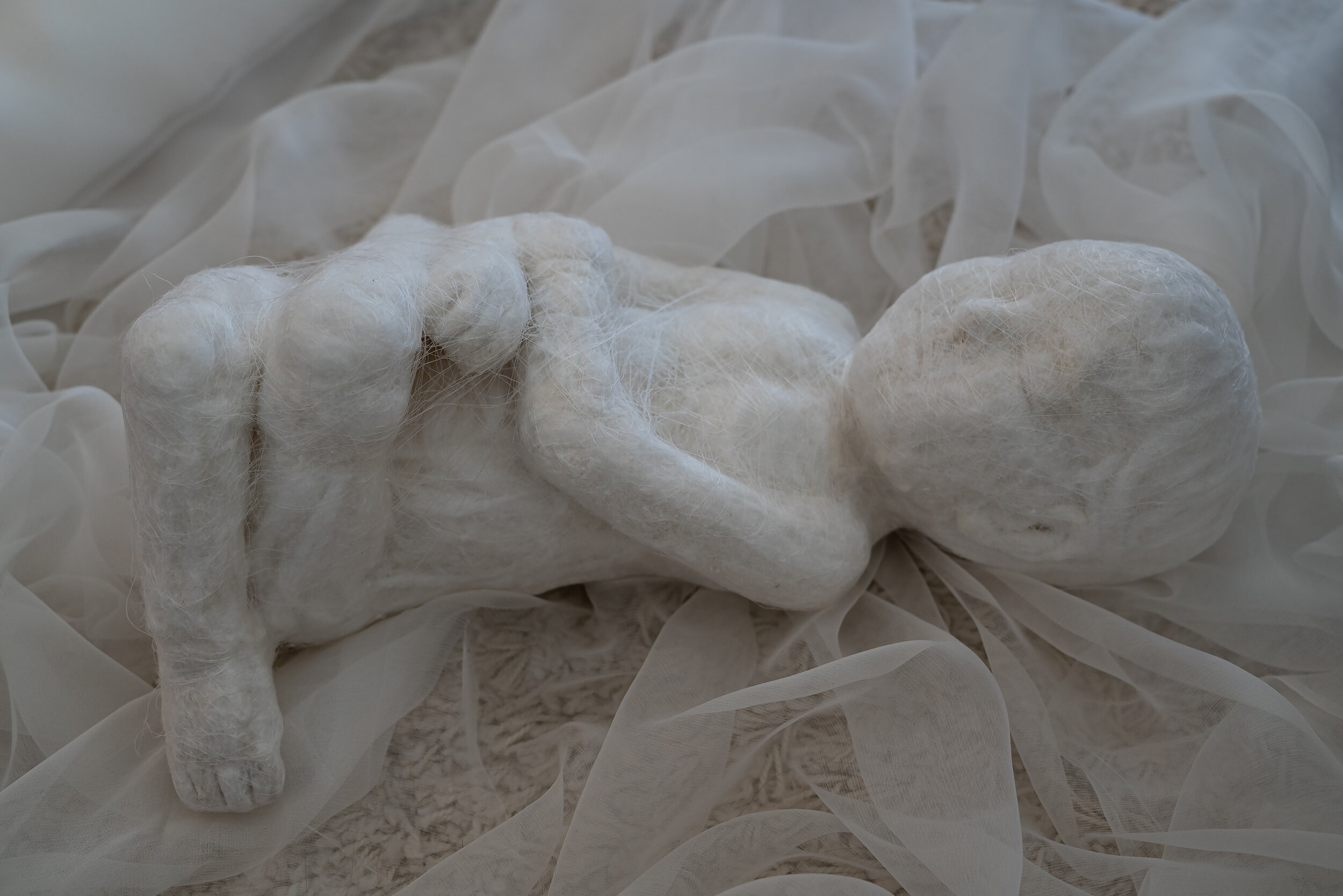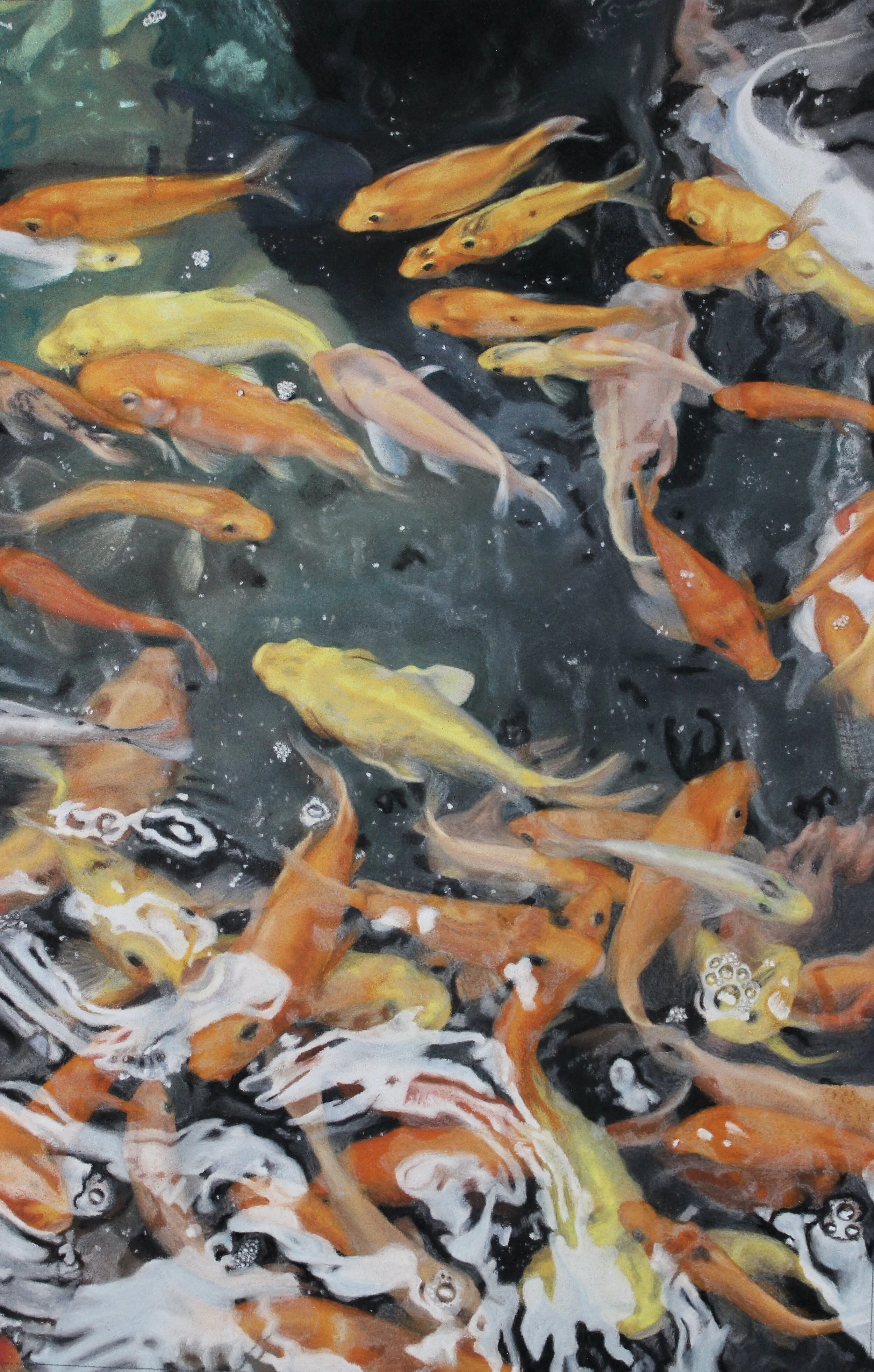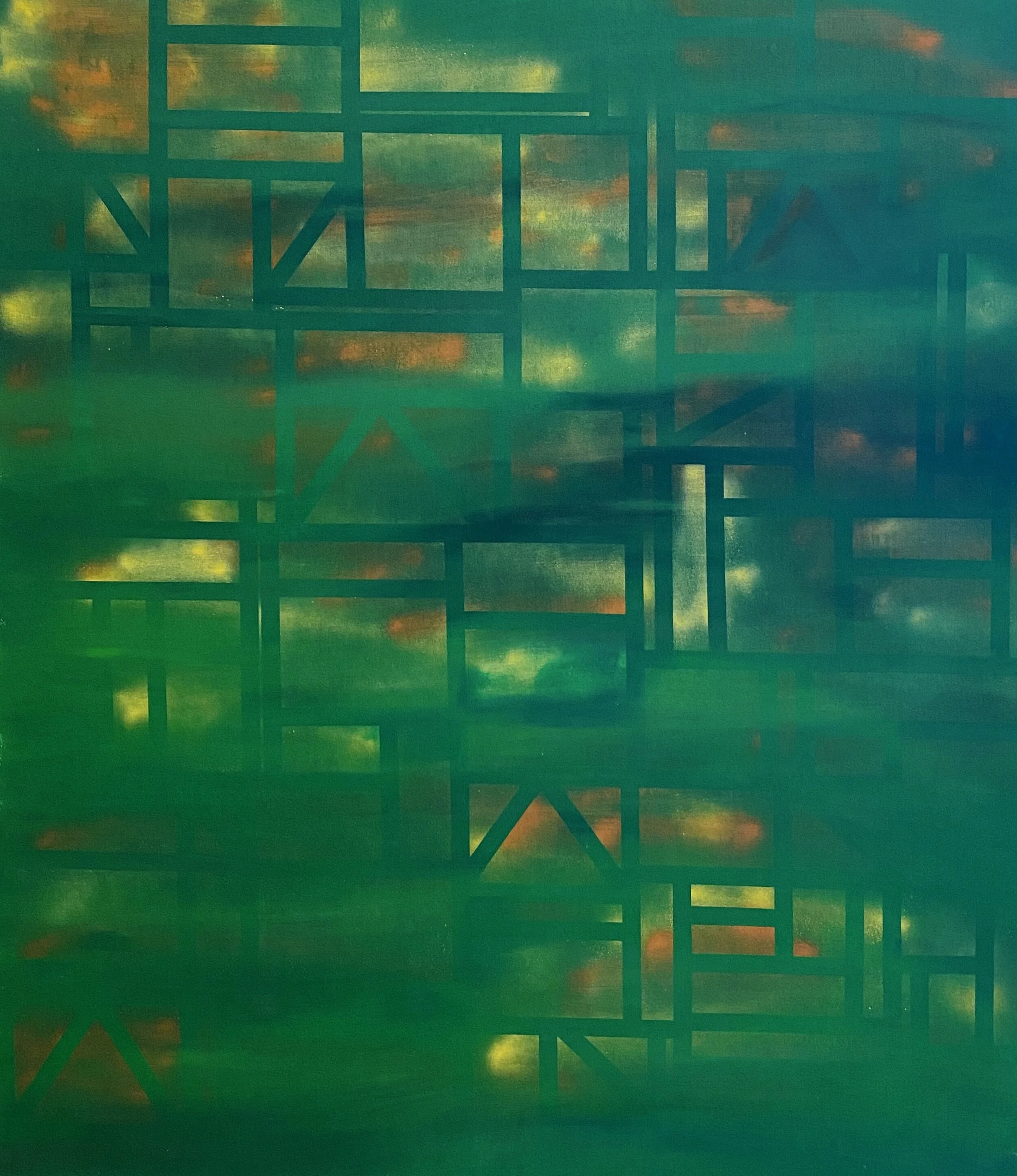Interview with Aomi Kikuchi
Aomi Kikuchi is a creator of innovative fine arts inspired by Buddha’s Philosophy, impermanence, insubstantiality, and suffering of all life. She started her career as a fashion designer, and she has a professional Yuzen Kimono Dyeing skill with about thirty years career. While she has a strong obsession with silk fabrics, she tries other materials, which have femininity and fragility such as fiber, goose down, cotton flower, glass, and film. Her artistic practice has been expanding from two-dimensional work to installation, sculpture, and film work. She received BFA from Kyoto University of Art and Design, and MFA from Pratt Institute.
Could you please introduce yourself and tell us how you started in the arts? and your first experience in art making?
Japanese traditional aesthetic sense is often described using the words of wabi-sabi and monono-aware. Wabi-sabi finds a taste in something that is not perfect like admiring the tilted taste of a bamboo vase of tea utensils and a distorted tea bowl. Monono-aware is another emotion of pity; pity on various creatures and the activities of nature and has an affinity with the feeling of appreciating nature with the gaze of charity. These senses are comparable with the aesthetic of modern society, which emphasizes perfect, robust and confronts seeking eternity. I was born in a place named Marunouchi, which means it was once inside the moat of Ueno Castle in Iga-city. It is about 5 minutes from the birthplace of Matsuo Basho, a famous poet known for haiku, the shortest form of poetry in the world. He wrote haikus on monono-aware. My hometown is famous for the Ninja, the Japanese silk braid used for the armor, the sword, the boxes for tea utensils and kimono bands. Iga-yaki ceramics have been used for the tea ceremony, which emphasized wabi-sabi. I was familiar with the multi-colored beautiful silk threads at home as my aunt did piecework of braid making. I wrote haiku and made Iga-yaki ceramics in my elementary classes. The hilly park around Ueno Castle has cherry blossoms in spring, fresh green in summer, red leaves in autumn, and desolate atmosphere in winter. Born and raised in such unique culture and rich nature, I have naturally acquired Japanese aesthetic senses.
Until the age of ten, I was a child in poor health and so loved reading books, drawing and doing handicrafts at home. I was good at drawing manga in my teenage years. I was drawing unconsciously all the time. When I took notes in class, I added illustrations, and I often drew pictures on the back of exam papers. Drawing was not special to me, and I didn't feel the need to learn it. When I had to choose between music and art as electives, I chose music instead of art because I wanted to be able to read music. I did not belong to the art club activity and I did not take any art classes, but I remember drawing pictures on a class flag by myself for a sports festival. I drew manga on both sides of a large 1.5 meters cloth. Until then, I had never painted on such a large piece of cloth, even not on paper, but I painted my own way, and our class won the first prize of the sports festival event.
In order to become a fashion designer, I started to learn dressmaking and knitting at the age of 20. At the same time, I started to go to the Sakura Art Salon, an oil painting sketch class, and I painted plants, still life, and female nudes on canvas. The first motif I worked on was a potted red begonia, but one week later, on the classroom day, all the flowers had already fallen, and I couldn't draw to the end because it was a sketch class. I liked the scent of turpentine and the atmosphere of the class. I am still in possession of the works of a bisque doll and a still life with a guitar from that time.
How would you describe yourself and your artwork?
I've always been creative since childhood, but it took me a long time before I realized that I am an artist. Although I was not aware of my artistic nature, I learned the basics of painting, which include Western painting, Japanese painting, and calligraphy. As for techniques of ceramic art, I practiced pottery making, painting on porcelain, bisque dolls, and glass work. Starting from the technique of Yuzen dyeing, which is the highest form of dyeing technique, I acquired general dyeing skills such as tie-dye, wax, stencil, silk screen, and natural dye. I also acquired skills of dressmaking, fashion design, machine knitting, hand knitting, lace, Japanese braid, Japanese embroidery, weaving and spinning.
When I was 39, I entered Kyoto University of Art and Design where I studied academic art for the first time. The professors treated me as a professional artist, not as a college student. During my school days, I organized a plant dyeing research group named Cochineal with my professors. We had group exhibitions of research presentations every year at museums in Tokyo and Kyoto. After graduating, I started to work in dyeing competitions for craft artists and became a member of the Japan Contemporary Arts and Crafts Association. At the crafts exhibition, there was a tendency not to display kimonos, and in accordance with this, I started to make panel works using silk fabric. From that time on, my work gradually departed from craft and moved on to fine art.
After seeing Miami Art Week in 2014, I decided to start my career in earnest as an artist, and came to New York the following April. After several solo exhibitions at galleries, including the Consulate General of Japan in New York, I entered the Pratt Institute's MFA to improve my language skills and learn more contemporary art. In graduate school, I studied with an emphasis on the skills required for professional artists, such as aesthetics, art criticism, artist as curator, and professional practice. By studying at graduate school, I reaffirmed my mission as an artist to produce works that can contribute to improving the world to be a better place. My work is always based on my artist statement, Buddha's preaching “Understanding and accepting the impermanence and insubstantiality of this world can liberate us from dissatisfaction and suffering''. By understanding impermanence and insubstantiality, we realize that this moment is an important moment that will never return. Having a mindful life without sticking to the past or having an endless desire for the future, is what I advocate through my work.
I learned a range of techniques and now these experiences help me as an artist as I have little limitation in material selection and technical constraints in the production of my work. In my innovative dyeing work based on the technique of Yuzen dyeing, elaborated patterns are dyed on layered extremely thin silk. This work is possible as I am familiar with the use of unique Yuzen brushes and controlling water of dye colors after many years of experience. Not only can this technique be used for layered fabric, but also large pieces can be dyed without a large space or supporting frame. I use my modeling skills cultivated in bisque dolls for my cotton sculpture. I incorporate Japanese embroidery elements to create the shape of insects such as Mosquito, Dragonfly and Moth. Materials I choose are delicate and difficult to handle, which require patience and meticulousness. For instance, raw silk thread is fine and sometimes invisible. Goose down floats in the air with exhaled breath, and the wind that comes up when you reach for your hand, it goes farther away. I would like to create innovative works by combining materials and techniques that have not been tried out before. I would like to be committed to environmental issues, dealing with scrap materials and bringing in new life to them using my acquired techniques. Although I have suspended dyeing kimonos after moving to NYC, I would like to try machine knitting kimonos and get back to using natural dyes, which I have been away for a while since I last dyed a bride's garment in Japan.
Where do you get your inspiration from?
My work is often inspired by the material. I have been dealing with various materials. I treated various types of fabrics for dressmaking. I used paper and canvas for oil paintings and Japanese paintings, and clay for bisque dolls and ceramics. However, having learned Yuzen dyeing, a traditional Japanese craft, I was completely captivated by silk. I have used only silk not only for kimonos, but also for panel works. In order to express my artist statement, the impermanence, ephemerality and fragility of this world, I began to use fragile and ephemeral materials such as extremely thin silk organza/ gauze, water-soluble glue, goose down, cotton, and glass. When I work with extremely thin silk organza/ gauze, they excite my heart, which I never felt using materials such as blank paper or canvas. When I contact the material, various ideas come out. For instance, I made spider webs from frayed organza threads. I want to continue to use exciting materials to create something that no one has seen yet, a world where people can be fascinated, surprised, and enjoy.
My artist statement itself is also the source of my creation. I often use goldfish and peony flowers as motifs, not just because I think they are beautiful. Goldfish have been bred and have unnecessarily large eyes, stomachs, and fins by humans seeking more beautiful and rare things. Ornamental flowers including Peony have also been improved to bloom larger. Flowers of fruits and vegetables are small. The original purpose of flowers is to bloom in order to bear fruit and to connect life, but if nutrients are taken to bloom the huge flowers, it will not be possible for the flower to bear fruit. Human desires create suffering not only for themselves but also for these creatures and plants. I use frogs, moths, mosquitoes and even molds as motifs and carefully shape them because Buddha argues that living things are equally important. It may not be anything but human ego to dismiss life as a pest or a bug just for human convenience. Substances including our body can not be eternal and looking around this world with eyes of mercy, I find motifs from anywhere around me.
What emotions do you hope the viewers experience when looking at your art?
When viewers see my work, I want them to feel my artist statement, the impermanence of this world, the ephemerality, and the stupidity of humans’ desires. Then I hope viewers can live and care for the present together with various living things because we miraculously share the moment. I sincerely wish viewers to live a mindful life with the mercy of love, Buddha preaching.
When do you know that an artwork is finished ?
In the case of dye works, the time of completion comes when I can no longer touch it. If the production process is clear, the completion is the end of the process. In the case of cotton sculptures, it is difficult to determine the finishing point because it is a work of repetition of shaving and adding. However, in my cotton sculpture work, I intentionally leave the slightly unfinished texture to show the nature of the material.
What has been the most exciting moment in your art career so far?
The most exciting moment is when I try the new way of using materials and techniques to make new work. No matter how familiar with the materials and techniques I may be, when I take a completely new approach, it doesn't always work as I expect. I saw a big dying dragonfly on the roadside of Brooklyn last summer and was fascinated by it and made a three-dimensional dragonfly for the first time. I wondered what the torso would be and what the legs would look like, so I tried materials and techniques until my work was matched to my intention. When it was finally completed, it felt like an exhilaration beyond one mountain.
How long does it take to produce one work?
When I was making kimonos while studying Yuzen dyeing, some of my works took more than one year to complete. I produce relatively large works including ceremonial kimonos, Japanese biyo-bu: folding screens, and layered installation work. Even for small three-dimensional work, it takes time for each one as I work meticulously. On the other hand, some of my works take much shorter time like my drawing ink work, which only takes about 10 minutes as it is done by injecting ink into glue strokes.
What exciting projects are you working on right now?
Under the theme of “Infinity”, I have started a new series of dyeing works that use natural dyes and mordants to transfer the shapes of objects around me, including waste materials, to form the shape of infinity. In this work, the shape of infinity is formed using fleeting and fragile materials such as petals and shredded paper. Based on the idea that there is no eternity in this world, which Buddha preaches, I create it in a position to deny infinity. However, I affirm infinity in the sense that even if each life or object ends its own existence, creatures and plants will pass life to the next generation, and material will also change shape and continue to exist.
Email: aomikikuchi@gmail.com
Website: https://www.aomikikuchi.com/
Instagram: https://www.instagram.com/aomikukuchi/












